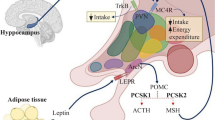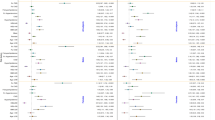Abstract
To investigate the association of tag-SNPs and haplotype structures of the CIDEA gene with obesity in a Han Chinese population. Five single nucleotide polymorphisms (SNPs) (rs1154588/V115F, rs4796955/SNP1, rs8092502/SNP2, rs12962340/SNP3 and rs7230480/SNP4) in the CIDEA gene were genotyped in a case–control study. Genotyping was performed using the sequenom matrix-assisted laser desorption/ionization time-of-flight mass spectrometry iPLEX platform. There were significant differences between the obese and control groups in genotype distributions of V115F (P < 0.001), SNP1 (P = 0.006) and SNP2 (P = 0.005). Carriers of V115F-TT, SNP1-GG and SNP2-CC genotypes had a 2.84-fold (95 % CI 1.73–4.66), 2.19-fold (95 % CI 1.09–4.38) and 4.37-fold (95 % CI 1.21–15.08) increased risk for obesity, respectively. Haplotype analysis showed that GTTC (SNP1/SNP2/V115F/SNP4) had 1.41-fold (95 % CI 1.02–1.95) increased risk for obesity; whereas, haplotype TTGC had 0.48-fold (95 % CI 0.24–0.96) decreased risk for obesity. Using the multifactor dimensionality reduction method, the best model including SNP1, SNP2, V115F and SNP4 polymorphisms was identified with a maximum testing accuracy to 59.32 % and a perfect cross-validation consistency of 10/10 (P = 0.011). Logistic analysis indicated that there was a significant interaction between SNP1 and V115F associated with obesity. Subjects having both genotypes of SNP1/GG and V115F/TT were more susceptible to obesity in the Han Chinese population (OR 2.66, 95 %: 1.22–5.80). Genotypes of V115F/TT, SNP1/GG and SNP2/CC and haplotype GTTC of CIDEA gene were identified as risk factors for obesity in the Han Chinese population. The interaction between SNP1 and V115F could play a joint role in the development of obesity.


Similar content being viewed by others
References
Stunkard AJ, Sørensen TIA, Hanis C et al (1986) An adoption study of human obesity. N Engl J Med 314:193–198
Bouchard C, Tremblay A, Després JP et al (1990) The response to long-term overfeeding in identical twins. N Engl J Med 322:1477–1482
Chagnon YC, Rice T, Pérusse L et al (2001) Genomic scan for genes affecting body composition before and after training in Caucasians from HERITAGE. J Appl Physiol 90:1777–1787
Chen W, Li S, Cook NR et al (2004) An autosomal genome scan for loci influencing longitudinal burden of body mass index from childhood to young adulthood in white sibships: the Bogalusa heart study. Int J Obes Relat Metab Disord 28:462–469
Parker A, Meyer J, Lewitzky S et al (2001) A gene conferring susceptibility to type 2 diabetes in conjunction with obesity is located on chromosome 18p11. Diabetes 50:675–680
Inohara N, Koseki T, Chen S et al (1998) CIDE, a novel family of cell death activators with homology to the 45 kDa subunit of the DNA fragmentation factor. EMBO J 17:2526–2533
Zhou Z, Yon Toh S, Chen Z et al (2003) Cidea-deficient mice have lean phenotype and are resistant to obesity. Nat Genet 35:49–56
Gummesson A, Jernås M, Svensson PA et al (2007) Relations of adipose tissue CIDEA gene expression to basal metabolic rate, energy restriction, and obesity: population-based and dietary intervention studies. J Clin Endocrinol Metab 92:4759–4765
Nordström EA, Rydén M, Backlund EC et al (2005) A human-specific role of cell death-inducing DFFA (DNA fragmentation factor-α)-like effector A (CIDEA) in adipocyte lipolysis and obesity. Diabetes 54:1726–1734
Dahlman I, Kaaman M, Jiao H et al (2005) The CIDEA gene V115F polymorphism is associated with obesity in Swedish subjects. Diabetes 54:3032–3034
Zhang L, Miyaki K, Nakayama T et al (2008) Cell death-inducing DNA fragmentation factor [alpha]-like effector A (CIDEA) gene V115F (G–>T) polymorphism is associated with phenotypes of metabolic syndrome in Japanese men. Metabolism 57:502–505
Zhang L, Dai Y, Bian L et al (2011) Association of the cell death-inducing DNA fragmentation factor alpha-like effector A (CIDEA) gene V115F (G/T) polymorphism with phenotypes of metabolic syndrome in a Chinese population. Diabetes Res Clin Pract 91:233–238
Zhopu BF, Cooperative Meta-Analysis Group of Working Group on Obesity in China (2002) Predictive values of body mass index and waist circumference for risk factors of certain related diseases in Chinese adults: study on optimal cut-off points of body mass index and waist circumference in Chinese adults. Biomed Environ Sci 15:83–96
Zhang J, Zhang L, Song MS et al (2010) Detection of HBV-DNA in dried bloodstains on filter paper by nested polymerase chain reaction. Lab Med 41:535–539
Jurinke C, van den Boom D, Cantor CR et al (2001) Automated genotyping using the DNA MassArray™ technology. Methods Mol Biol 170:103–116
Söderlund-Strand A, Dillner J, Carlson J (2008) High-throughput genotyping of oncogenic human papilloma viruses with MALDI-TOF mass spectrometry. Clin Chem 54:86–92
Schaeffeler E, Zanger UM, Eichelbaum M et al (2008) Highly multiplexed genotyping of thiopurine S-methyltransferase variants using MALDI-TOF mass spectrometry: reliable genotyping in different ethnic groups. Clin Chem 54:1637–1647
Barrett JC, Fry B, Maller J et al (2005) Haploview: analysis and visualization of LD and haplotype maps. Bioinformatics 21:263–265
Ritchie MD, Hahn LW, Roodi N et al (2001) Multifactor-dimensionality reduction reveals high-order interactions among estrogen-metabolism genes in sporadic breast cancer. Am J Hum Genet 69:138–1347
Lin SC, Li P (2004) CIDE-A, a novel link between brown adipose tissue and obesity. Trends Mol Med 10:434–439
Dahlman I, Linder K, Nordström EA et al (2005) Changes in adipose tissue gene expression with energy-restricted diets in obese women. Am J Clin Nutr 81:1275–1285
Puri V, Ranjit S, Konda S et al (2008) Cidea is associated with lipid droplets and insulin sensitivity in humans. Proc Natl Acad Sci USA 105:7833–7888
Ito M, Nagasawa M, Hara T et al (2010) Differential roles of CIDEA and CIDEC in insulin-induced anti-apoptosis and lipid droplet formation in human adipocytes. J Lipid Res 51:1676–1684
Tan EK, Tan C, Shen H et al (2003) Alpha synuclein promoter and risk of Parkinson’s disease: microsatellite and allelic size variability. Neurosci Lett 336:70–72
Chartier-Harlin MC, Kachergus J, Roumier C et al (2004) Alpha-synuclein locus duplication as a cause of familial Parkinson’s disease. Lancet 364:1167–1169
Zhang Z, Wang S, Wang M et al (2008) Genetic variants in RUNX3 and risk of bladder cancer: a haplotype-based analysis. Carcinogenesis 29:1973–1978
Sano M, Kuroi N, Nakayama T et al (2005) Association study of calcitonin-receptor-like receptor gene in essential hypertension. Am J Hypertens 18:403–408
Lehman DM, Fu DJ, Freeman AB et al (2005) A single nucleotide polymorphism in MGEA5 encoding O-GlcNAc-selective N-acetyl-β-d glucosaminidase is associated with type 2 diabetes in Mexican Americans. Diabetes 54:1214–1221
Szymańska E, Bouwman J, Strassburg K et al (2012) Gender-dependent associations of metabolite profiles and body fat distribution in a healthy population with central obesity: towards metabolomics diagnostics. OMICS 16:652–667
Acknowledgments
All participants that enrolled in this study were gratefully acknowledged. This work was financially supported by the Grants from Natural Science Foundation of China (30800949, 81273170), the China National “12th Five-Year” Plan for Science and Technology Support (2012BAI37B03), the China National High Technology Research and Development Program-863 (2006AA02Z434), Beijing Municipal Commission of Education (SQKM201210025010), Novel Star of Science Program, Beijing, China (2009A47), China Scholarship Council (2012-6021), Beijing Municipal Commission of Education for Overseas Students (2011-No165), Academic Human Resources Development in Institutions of Higher Learning Under the Jurisdiction of Beijing Municipality, PHR (IHLB) (PXM2011_014226_07_000028) the Australia-China Sciences Research Foundation (ACSRF06444), and the Importation and Development of High-Caliber Talents Project of Beijing Municipal Institutions.
Author information
Authors and Affiliations
Corresponding authors
Rights and permissions
About this article
Cite this article
Wu, J., Zhang, L., Zhang, J. et al. The genetic contribution of CIDEA polymorphisms, haplotypes and loci interaction to obesity in a Han Chinese population. Mol Biol Rep 40, 5691–5699 (2013). https://doi.org/10.1007/s11033-013-2671-7
Received:
Accepted:
Published:
Issue Date:
DOI: https://doi.org/10.1007/s11033-013-2671-7




